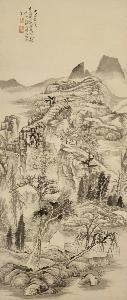Ji Gong
Ji Gong;Daoji
Place: Guilin
Born: 1642
Death: 1707
Biography:
Ji Gong, also known as Daoji, was a Chan Buddhist monk born in Guilin, Guangxi province, China in 1642. He was a direct descendent of a Ming imperial prince and was known for his wild and eccentric behavior, as well as his supernatural powers which he used to help the poor and stand up to injustice.
Early Life and Career
Ji Gong's early life is not well documented, but it is believed that he was born into a wealthy family and received a good education. However, he rejected the traditional path of wealth and power, instead choosing to become a Buddhist monk. He purportedly possessed supernatural powers through Buddhist practice, but didn't follow Buddhist monastic rules by consuming alcohol and meat.
Artistic Style
Ji Gong's painting style is characterized by bold brushstrokes and vibrant colors. His works are highly regarded for their expressive and emotive qualities, and are often compared to the Bunjinga Art Movement, a style of Japanese painting that emerged during the Edo period. The Bunjinga style emphasized individual expression and personal interpretation over technical skill, and was heavily influenced by Chinese literati painting and calligraphy.
Notable Works
Some of Ji Gong's notable works include Landscape, a painting that showcases his mastery of bold brushstrokes and vibrant colors. This painting is housed at the National Gallery of Victoria in Melbourne, Australia. Another notable work is Wisteria and Birds, a traditional Chinese ink wash painting that demonstrates Ji Gong's skillful use of ink and color.
Influence and Legacy
Ji Gong's influence on Chinese art and culture cannot be overstated. He is mentioned by Buddhists in folktales and kōans, and sometimes invoked by oracles to assist in worldly affairs. His legacy can also be seen in the works of other Chinese artists, such as Chen Yifei, who was influenced by Ji Gong's bold and expressive style.
- Key aspects of Ji Gong's life and art:
- Born in 1642 in Guilin, Guangxi province, China
- Direct descendent of a Ming imperial prince
- Known for his wild and eccentric behavior and supernatural powers
- Purportedly possessed these powers through Buddhist practice
- Notable works:
- Landscape, housed at the National Gallery of Victoria
- Wisteria and Birds, a traditional Chinese ink wash painting
- Influence and legacy:
- Mentioned by Buddhists in folktales and kōans
- Invoked by oracles to assist in worldly affairs
- Influenced other Chinese artists, such as Chen Yifei
For more information on Ji Gong and his art, visit Ji Gong's page on Wikioo.org. You can also explore the Bunjinga Art Movement and other Chinese art styles on Wikioo.org.

